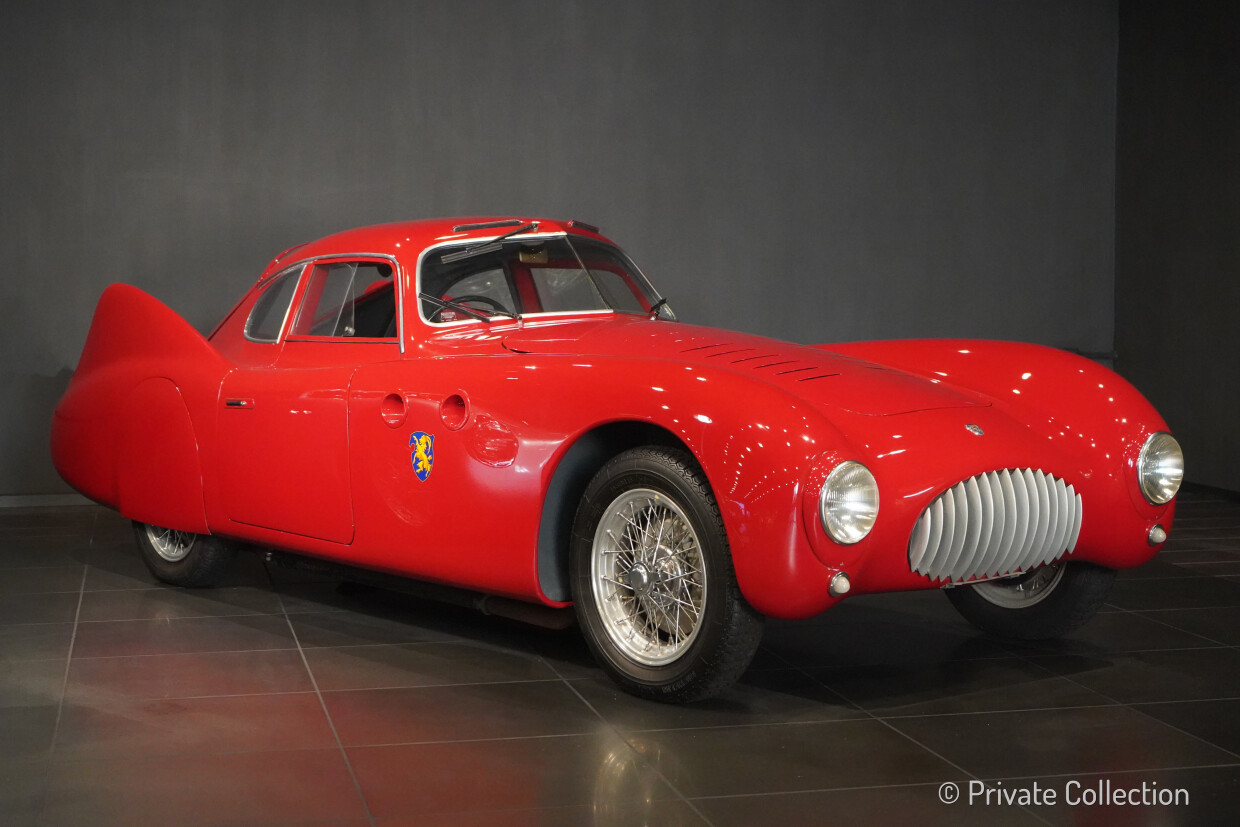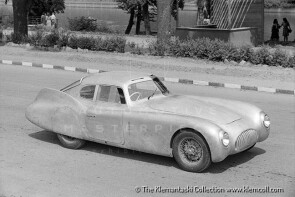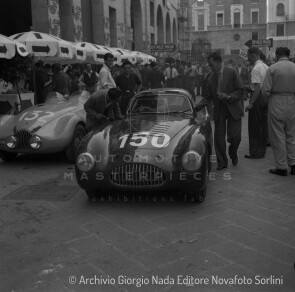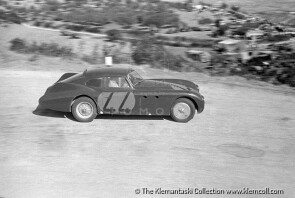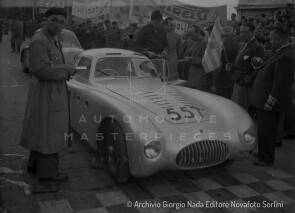
1947 Cisitalia 202 Coupé Mille Miglia
ON/OFF
Why am I an Automotive Masterpiece?
K. Famous chassis’ cars
The first chassis of 202 Coupé Mille Miglia bodyworked by Carrozzeria Alfredo Vignale & C.
L. Limited edition cars
no. 2 manufactured, 1st built
Founded in 1939 by Turinese textile industrialist Piero Dusio to manufacture sports equipment, the "Consorzio Industriale Sportiva Italia" (CISItalia) amassed a fortune for its former owner of the Juventus football club, making military uniforms during World War II. An experienced amateur driver, Dusio used his fortune to become involved with the sport he loved. After winning his class in the 1937 Mille Miglia, he began to explore the possibilities of building his own racing cars. Cisitalia's first model was the D46, which appeared in 1946; it was a small single-seater using a tubular steel space-frame chassis crafted at Cisitalia's bicycle factory to support readily-available Fiat mechanicals, such as the Fiat 1089cc engine and Fiat 500 suspension. After fifty D46s were produced and the model achieved a debut victory in the Coppa Brezzi in Turin, Cisitalia focused on building a small passenger car based on the D46. In the summer of 1946, Dante Giacosa began the design of the 202 project. Giacosa, who worked for Dusio under "permission", foreseeing his full-time return to Fiat, had proposed the hiring of the young engineer Giovanni Savonuzzi, an eclectic and versatile technician whom he had met in Fiat's aviation engine testing department. Giovanni Savonuzzi completed the 202 project. Upon the tubular chassis made of chrome-molybdenum steel, chosen also to accommodate the mechanics lower, the 4-cylinder in-line engine of 1089 cc derived from the Fiat 1100 but extensively modified was mounted, developing 60 hp at 5500 rpm. Only the engine block remained original, while the OHV aluminum cylinder head was completely new. The exhaust and intake manifolds were also specific as well as the steel crankshaft, connecting rods, pistons, and dry sump lubrication. The rear live axle, with longitudinal leaf springs and friction dampers, and the 4-speed manual gearbox with floor lever, were derived from the Fiat 1100, while the front independent wheel suspensions with transverse leaf spring, and steering came from the 500 "Topolino". The car had wire wheels and drum brakes. On this basis, Savonuzzi had various types of bodywork made, closed and open, with the aim of participating in the 1947 Mille Miglia, the first organized after the war. The first chassis was equipped with an aerodynamic aluminum berlinetta body by Carrozzeria Colli. This specimen is called "Cassone" due to its linear profile and lack of appendages. Not entirely satisfied with the "Cassone", Savonuzzi designed a second berlinetta, also in aluminum but made by Alfredo Vignale, according to the engineer's precise instructions. Building this coupé allowed Vignale, at the time the departmental head of Stabilimenti Farina, to set up his own coachbuilding company. The 202 Coupé Mille Miglia (CMM), also known as the "Aerodinamica Savonuzzi", featured details that would be reused on future Cisitalia models, especially in the front end. It seems that Savonuzzi initially did not draw a proper design but started from a clay model. Whatever the truth may be, the final result is exceptional: the car's nose is flattened towards the ground with a clear lifting effect, the flat sides form two side walls higher than the engine hood; prominently at the rear are the very pronounced fins that have a directional function and solve stability problems in straight lines, given by the reduced section of the tires, the lightweight, and the high speeds achievable. The rear wheels are fully faired, a small spoiler is placed above the rear window to properly guide the airflow, while two deep recesses outline the lower part of the tail to better extract the air between the ground and the completely faired car floor. The car was extensively tested in the wind tunnel at the Politecnico di Torino. More recently, the car, in the Pininfarina wind tunnel, demonstrated a drag coefficient of just 0.29. Confirming the goodness of the adopted aerodynamic solutions were the tests conducted on the Turin-Milan motorway, which recorded a top speed of 201 km/h. The 202 CMM was included in the Cisitalia price list but only two specimens are known to have been produced: the *00 1C MM* and the *00 2C MM*. This second specimen was painted silver and equipped with a 1200 cc engine, competed in the 1948 Mille Miglia, won its class at the Pescara Circuit, and achieved success in Argentina in the following years. Destined for competition, the 202 model, in its various variants, was initially presented in some minor races. But on June 22, 1947, the Cisitalia team showed up at the start of the Mille Miglia in Brescia with five cars: two experimental berlinettas and three spiders. The 202 Coupes were the "Cassone" berlinetta, entrusted to Bernabei – Pacini and the "Savonuzzi" berlinetta entrusted to Taruffi – Buzzi. The 202 SMMs were Nuvolari - Carena's spider, Minetti - Facetti's spider, and Dusio (himself) - Macchieraldo's "Razzo" spider. On the descent towards Rome, Dusio's "Razzo" Spider and Taruffi's berlinetta were forced to retire. The elderly and ill Nuvolari, instead, achieved an incredible second place. Behind him: Bernabei's "Cassone" in third place and Minetti's Spider in fourth.
The Cisitalia 202 Coupé Mille Miglia "Aerodinamica Savonuzzi" with chassis *00 1C MM* is the first of (it is believed) only two specimens produced. It is the only one characterized by the two oval portholes on the sides, reintroduced only on the 202B in 1950. The specimen is one of the two berlinettas (the other was the 202 "Cassone") officially entered by Cisitalia in the 1947 Mille Miglia, and it was certainly the car with the most futuristic shapes in the race. It was driven by the experienced Piero Taruffi "the silver fox", who had co-founded, with Piero Dusio, Cisitalia, and was, therefore, a natural choice: he raced in his career a total of 15 Mille Miglia. Taruffi, paired with Buzzi, has little luck and has to retire due to an engine failure. According to Savonuzzi's own memories, the car was actually leading the race when a piston broke. He recalls that, after the warehouse stock of forged pistons was exhausted, Cisitalia was forced to resort to cast ones, as on Taruffi's unlucky car, which indeed failed. The *00 1C MM* still raced at the Pescara Circuit, and at the 1948 Mille Miglia it redeemed itself: still entered by Cisitalia, with drivers Chieregato – Volpini, the car achieved an honorable 31st overall / 17th in class. In the autumn of that year, the car changed ownership: Cisitalia sold it to the driver Franco Cornacchia, who immediately resold it to the well-known car dealer "Enrico Minetti" in Milan, in the midst of his dispute with the historic partner Lancia and in search of new horizons. The dealer, in turn, sold it to the “Manifattura Tessile Bustese” company. In 1949, the *00 1C MM* returned for a third time to the Mille Miglia, privately, with the crew consisting of Angelo Migliorini and Gastone Crepaldi, renowned Ferrari dealer and leader of the Scuderia Italfrance. The car raced two more times in 1949, then disappeared from the sports chronicles. After several changes of ownership, the car was found, around 1970s, complete but in need of full restoration. It went into the hands of Nino Balestra, a car historian and attentive Cisitalia connoisseur. Subsequently restored, it became part of important collections. Since 1988, the car has returned to race the Mille Miglia (historic) several times, as well as other races and concours d'elegance. The *00 1C MM* is featured in many books, including Sandro Binelli's Mille Miglia Chassis book Volume III.
